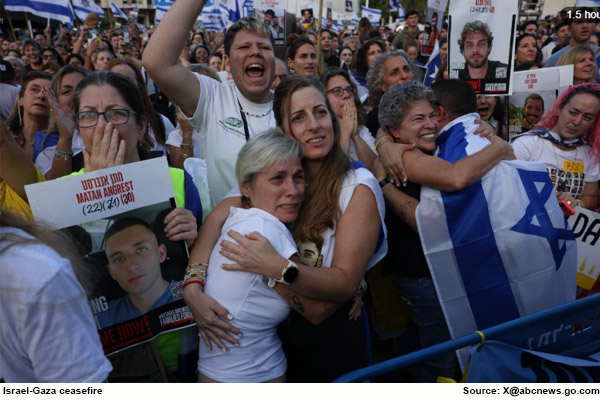Israel-Gaza ceasefire: Several important agreements pertaining to the truce between Israel and Gaza have surfaced as a result of recent negotiations. The agreement’s provisions for humanitarian aid, the possible exchange of prisoners, and the suspension of hostilities are its main features. However, putting this truce into effect comes with a number of serious hazards.
Firstly, the agreement faces the challenge of maintaining compliance from both parties. Historical precedents indicate that past truces have often been violated, and there remains skepticism around the willingness of both sides to adhere to the terms. Additionally, internal divisions within each side could hinder the enforcement of the truce, particularly if hardline factions oppose compromise.
Moreover, obstacles include the ongoing tensions between various groups within Gaza, as well as the political landscape in Israel, where shifts in leadership or public opinion could influence commitment to the truce. The humanitarian situation also presents a critical risk; if aid does not reach those in need or if conditions on the ground do not improve, local sentiments could quickly turn against the truce, leading to a breakdown in relations.
In summary, while the truce agreement represents a hopeful step forward, its success is precariously balanced on the cooperation of both parties and their ability to navigate internal and external pressures that threaten to destabilize the situation. The coming weeks are crucial in determining whether this truce can serve as a pathway to lasting peace or if it will succumb to the same cycles of violence that have historically plagued the region.
Here are some limited outlooks and expert opinions on how stable the current Israel-Gaza ceasefire might be — including risk factors, what could help hold it, and what might cause it to break down. These are based on recent analysis (as of late 2025) from different media, think tanks, and regional experts.
What’s the Deal
Ceasefire & Hostage Exchange
Israel and Hamas have agreed to a truce under a U.S.-brokered plan.
As part of it, Hamas will release 20 living hostages in return for the release of about 1,900+ Palestinian prisoners held by Israel.
The ceasefire facilitates partial withdrawal of Israeli forces from Gaza and allows significant humanitarian access (aid, medical supplies).
First Hostage Release Already Happened
The first 7 hostages have been handed over to the Red Cross from Gaza and are on their way back to Israel.
This is seen as a significant symbolic and practical step.
Humanitarian Relief in Gaza
The UN will ramp up aid deliveries — food, medical supplies, shelter support — especially during the first 60 days of the ceasefire.
Some aid distribution sites (run by U.S.-Israeli-backed groups) are being shut down or relocated as part of the agreement.
Political & Security Promises
Israel’s Prime Minister Netanyahu has reaffirmed the intention to disarm Hamas and demilitarize Gaza, even under the ceasefire.
Hamas has committed to adhering to the ceasefire timeline (provided Israel does so too).
However, key issues like Gaza’s governance, security guarantees, and long-term status remain unresolved.
Challenges & Risks
Fragility of the Truce
Peace deals in this region have failed before. Any violation by either side (military or political) could collapse the agreement.
Disputed Conditions
Israel insists on full demilitarization and sees Hamas losing its military capabilities. Hamas, in turn, wants guarantees for its survival and role in Gaza. These are tough demands to reconcile.
Implementation & Oversight
Ensuring the terms are honored — troop withdrawals, prisoner releases, safe humanitarian corridors — requires strong enforcement and external monitoring.
Humanitarian Crisis Remains Severe
Gaza has endured large-scale destruction, widespread displacement, shortages of food, water, medical infrastructure. Ceasefire alone won’t resolve these structural problems.
Political Pressure & Domestic Audiences
In Israel, right-wing opposition may object to concessions. In Gaza/Palestine, Hamas and other actors will push to maintain their legitimacy and control.
Where This Could Head: Mid / Long Term
Short to Mid Term
If the ceasefire holds, we may see:
Steady release of hostages and prisoners
Partial rollback of military operations
Surge in humanitarian aid and rebuilding
Negotiations for a longer peace or a permanent deal
Long Term Prospects
A lasting peace requires:
A political framework for Gaza’s governance
Security guarantees that prevent renewed conflict
Reconstruction of infrastructure
Addressing root issues: territory, rights, refugees

